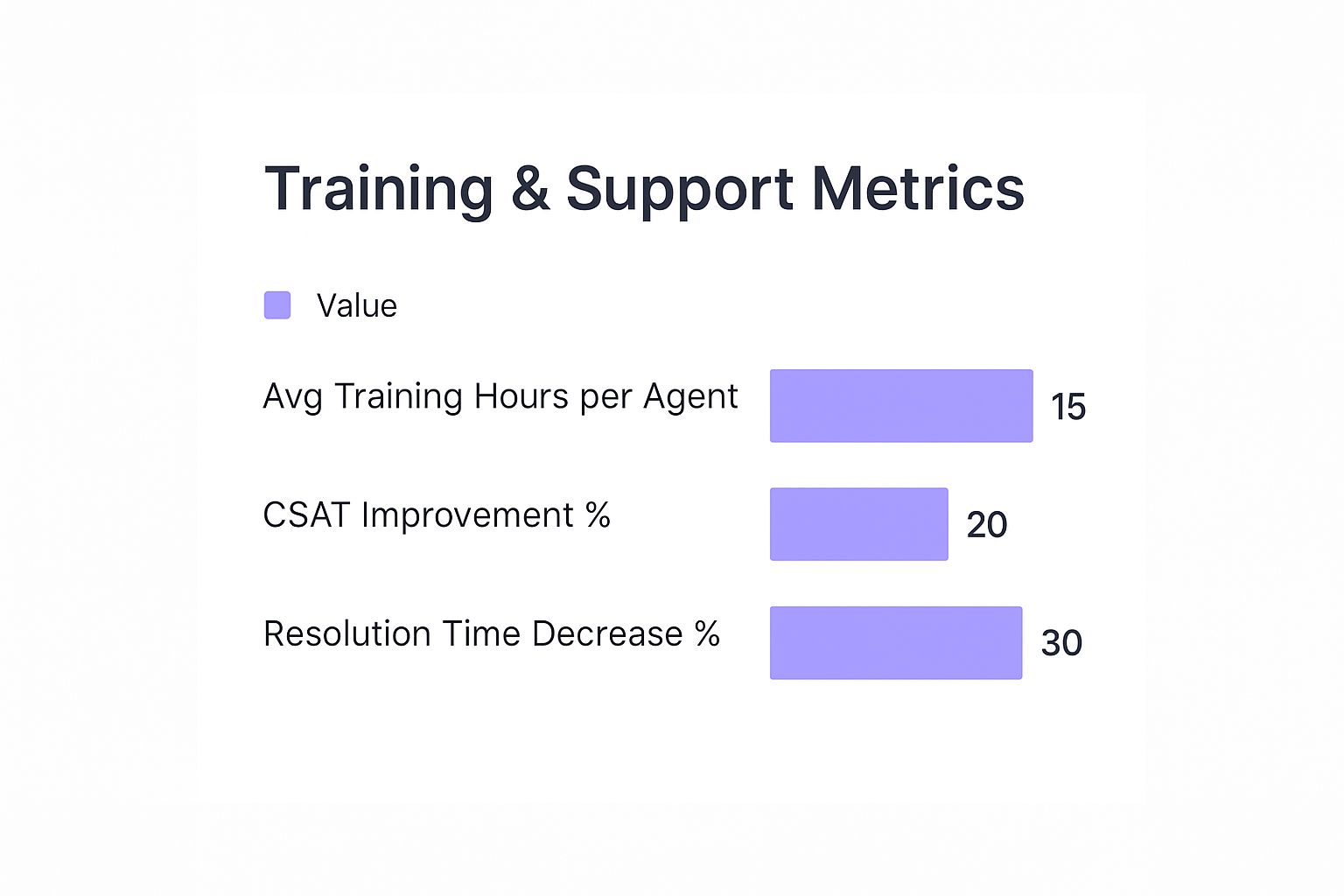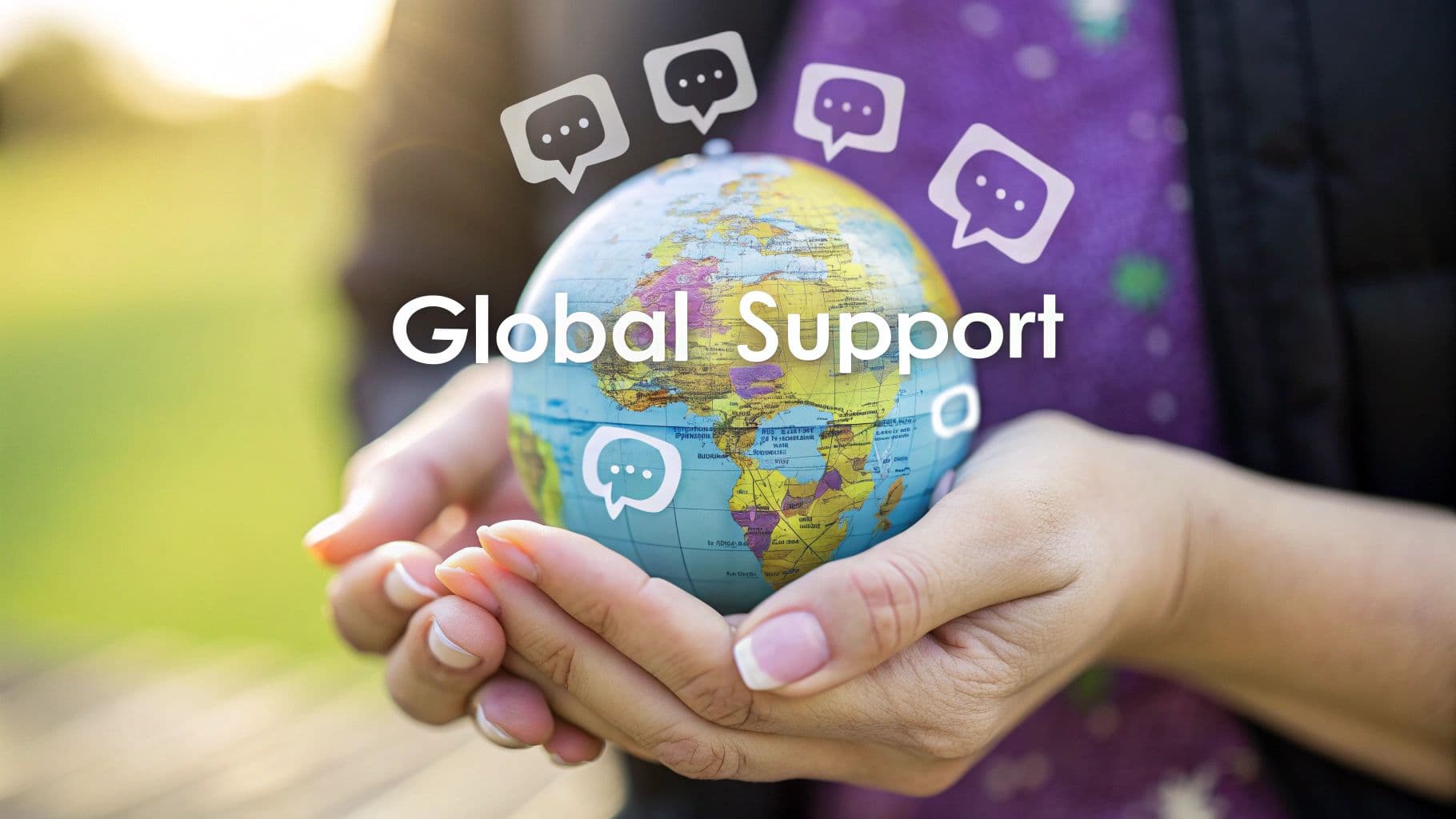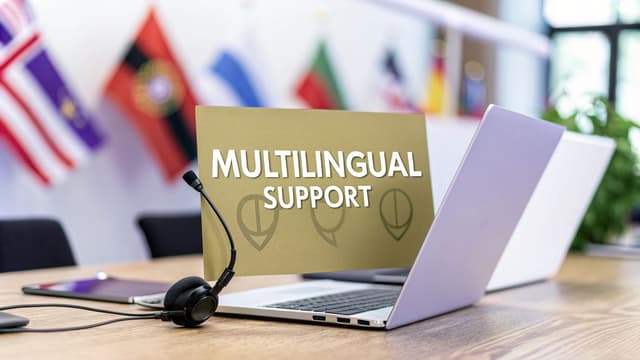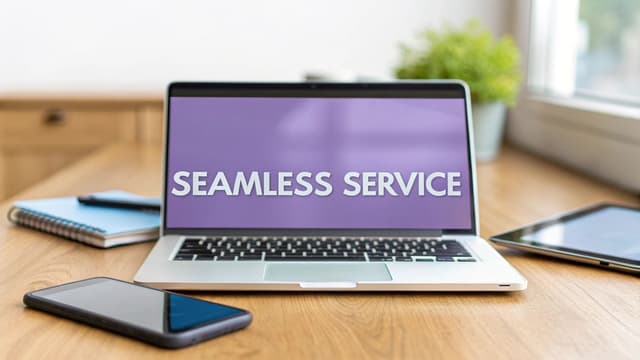Why Language Barriers Are Killing Your Growth
Think of your business as a bustling marketplace with amazing products. You've got everything set up perfectly, but there's a catch: the only way in is across a single, narrow bridge. Anyone who doesn't speak your language is stuck on the other side, unable to see what you offer. This is what happens when you operate without multilingual customer service—you create invisible walls that block off a huge global audience.
When a customer in Madrid gives up on their shopping cart because they can't find help in Spanish, it's more than just one lost sale. It’s a sign of a much larger growth problem. Language is the bridge that connects your business to billions of potential buyers. Without it, you're not just missing individual sales; you're missing out on entire markets. Your single-language approach may seem simple, but it’s quietly leaving significant revenue behind.
The Real Cost of Misunderstanding
The harm from language barriers goes beyond just the immediate financial hit. Each time a customer struggles to communicate, it chips away at your brand's reputation. When people feel misunderstood or ignored, they don’t just leave quietly. They share their frustrating experiences, creating a negative image in local communities that can be very hard to fix.
Successful companies see this clearly. They don't treat multilingual support as an expense but as a powerful way to get ahead of the competition. They know that succeeding internationally isn’t just about having the best product; it’s about making customers feel truly heard and respected. To explore this idea further, you can learn more about the strategic benefits of multilingual customer support and how to implement it. By speaking a customer's language, you create a real relationship, not just a transaction.
The Undeniable Link Between Language and Loyalty
The connection between language and business success is backed by strong data. Research shows that 60% of global consumers would rather do business in their native language and are more likely to buy when that support is an option. Even more telling, 70% of customers say that getting help in their own language directly impacts their loyalty to a brand.
The opposite is also true: nearly 29% of customers admit to switching to a competitor because of poor language support, which is a direct blow to customer retention. You can discover more insights about how language impacts customer loyalty from the full research. This data confirms a simple truth: putting effort into a solid multilingual customer service strategy is one of the most direct ways to build a loyal, worldwide customer base.
The ROI Story That Changes Everything
While the link between happy customers and a healthy business feels intuitive, executives often need to see the numbers before backing new projects. Luckily, the case for multilingual customer service isn't just about goodwill; it's a compelling story told with real financial returns. When a company speaks its customers' language, it’s not just being polite—it's making a direct investment in its bottom line. The return on this investment (ROI) is a collection of connected financial gains.
Consider the experience of Zendesk, a major player in the customer service field. After putting a complete multilingual support plan into action, they found a stunning financial insight: customers who got help in their native language had a 23% higher lifetime value. Even better, these same customers showed a 31% lower churn rate. These numbers change multilingual support from a "nice-to-have" feature into a core strategy for lasting growth. This isn't a one-off event; it’s a pattern repeated across many industries.
Uncovering Hidden Value Drivers
The most apparent benefit is more revenue, but the true financial impact runs much deeper. Several hidden value drivers, often missed in a simple cost-benefit check, add greatly to the ROI of a multilingual strategy.
- Reduced Escalation Costs: When a customer can clearly describe their problem in their own language, agents solve it more quickly. This drastically cuts down on the tickets that need to be passed up to more senior (and more expensive) support staff.
- Improved First-Call Resolution (FCR): Language barriers are a leading cause of repeat calls and emails. Fixing an issue on the first try isn't just efficient; it's a huge driver of customer happiness and operational savings.
- Powerful Word-of-Mouth: A great support experience in someone's own language can turn a happy customer into a vocal brand supporter. This organic marketing is especially effective in new international markets, creating a ripple effect that brings in new customers at almost no extra cost.
To better visualize how these investments pay off, let's break down the costs and returns. The following table provides a clear comparison of the initial expenses versus the measurable business benefits.
| Investment Category | Initial Cost | Annual ROI | Customer Impact | Market Expansion |
|---|---|---|---|---|
| Hiring Native Speakers | High (Salaries, recruiting) | Moderate (Higher agent efficiency reduces churn) | High (Personalized, culturally aware service) | Slow (Limited to languages with hired staff) |
| Translation Software | Low-to-Mid (Subscription fees) | High (Immediate coverage for multiple languages) | Moderate (Risk of literal, context-poor translation) | Fast (Scales easily to new regions) |
| AI-Powered Chatbots | Mid-to-High (Setup, integration) | Very High (24/7 support, instant resolution) | High (Consistent, fast answers for common questions) | Very Fast (Deployable across all digital channels) |
| Employee Training | Low (Time & materials) | Moderate (Boosts agent confidence and FCR) | Moderate (Improves handling of translated queries) | Limited (Supports existing markets better) |
This analysis shows that while hiring native speakers offers the highest quality interaction, AI-powered solutions provide the most scalable and financially efficient path to global market expansion and customer satisfaction.
The Growing Market for Multilingual Solutions
The financial logic is so strong that it’s driving major market growth. The global multilingual customer support software market is valued at around $285 million in 2025 and is expected to grow at a solid 7.1% each year through 2033. This growth is a direct result of globalization and the rising need for all-in-one support that works smoothly across languages. As more companies see the strategic need, investment in these technologies keeps climbing. You can read more about the multilingual software market trends to understand where the industry is heading.
Ultimately, the choice isn't between saving money and offering multilingual support. The real math involves weighing the high cost of language barriers—lost sales, high customer turnover, and a poor brand image—against the proven financial rewards of investing in true customer understanding. The ROI story confirms that speaking your customer’s language is one of the smartest financial moves a global business can make.
AI Translation That Actually Gets It Right

When you hear "AI translation" for multilingual customer service, you might picture clunky, robotic text that causes more confusion than it solves. But today's AI has evolved far beyond basic tools like Google Translate. Modern platforms aren't meant to replace human agents—they’re designed to give them superpowers. Smart businesses are now using AI to offer support that's not just fast, but also understands context and culture, all on a global scale.
Think of it like this: a basic translation tool is a pocket dictionary. It can tell you the word for "refund," but it has no idea about the frustration, urgency, or specific situation behind the customer's message. A sophisticated AI, however, acts more like a skilled human interpreter. It understands not just the words, but the meaning behind them, including tone and industry-specific language. This difference is what turns a frustrating experience into a helpful one.
Beyond Literal Translation: Context and Culture
The true strength of modern AI is its ability to grasp nuance. Imagine an Airbnb guest in Japan messaging a host in Brazil about a "small issue" with the heating. In some cultures, "small issue" is a polite way of saying "major problem." An AI trained on conversational data can pick up on this subtlety and alert the support team, stopping a minor complaint from becoming a crisis.
Likewise, an e-commerce platform like Shopify uses AI to handle product-specific terms across dozens of languages. When a customer asks about "drop shipping" or "inventory management," the AI recognizes these are not just words to be translated literally. They are concepts with specific meanings on the platform. This deeper understanding helps conversations flow naturally and leads to quicker solutions, keeping the customer experience strong.
Key Features of Advanced AI Translation Platforms
Not all AI tools are created equal. When bringing AI into your multilingual customer service, look for platforms that do more than just swap words.
- Contextual Understanding: The AI should analyze the entire conversation, not just one sentence, to figure out the customer's true intent.
- Industry-Specific Glossaries: The ability to teach the AI your company's unique terms is essential for accurate support, especially in specialized fields.
- Sentiment Analysis: The platform should identify emotions like frustration, happiness, or urgency. This helps agents prioritize tickets and adjust their tone.
- Seamless Integration: The best tools work directly inside your existing helpdesk or CRM, so agents don’t have to juggle multiple apps.
Scaling Support Without Sacrificing Quality
As the internet connects more of the world, businesses need to serve a global audience. The online world is becoming less English-centric, making high-quality multilingual support vital for building trust. By 2025, it's predicted that 80% of customer service interactions will involve AI, with multilingual chatbots becoming standard. You can discover more insights about multilingual AI trends on twig.so.
Advanced AI can automatically identify over 100 languages in real time, delivering culturally aware responses that feel authentic. When evaluating AI translation, a key factor is the range of supported languages for AI translation solutions to ensure you can reach a worldwide audience. This isn't just about reducing costs; it's about expanding what your company can do and building a support system that grows right alongside your business.
Your Strategic Implementation Roadmap
Turning your customer support from a single-language operation into a global powerhouse needs a clear plan. Building a successful multilingual customer service framework is like constructing a house. You wouldn't just start nailing boards together; you'd begin with a solid blueprint that maps out every step. This roadmap ensures you use your resources wisely, focus on high-impact opportunities, and sidestep common mistakes like expanding too quickly.
Step 1: Conduct a Comprehensive Language Audit
Your first task is to find out where your real opportunities are. A language audit isn't just about checking website traffic from different countries. You need to dig into your customer data to see where your most valuable interactions and growth potential are hiding.
- Analyze Your Customer Base: Dive into your CRM and sales data. Which countries or regions bring in the most revenue? Where are you seeing the quickest growth in new sign-ups?
- Review Support Tickets: Look at your existing support channels. Are you getting messages in languages you don’t officially support? A flood of tickets in Spanish or German is a strong signal of unmet demand.
- Assess Market Potential: Think beyond your current customers. Identify key markets for expansion where offering local language support could give you a serious advantage. Research from HappyFox shows 74% of customers are more likely to buy again from a business that provides support in their native language, showing a direct link between language and loyalty.
Step 2: Prioritize Languages With a Strategic Framework
Once you know which languages your customers use, you can't start supporting all of them at once. The trick is to prioritize strategically. A simple matrix can help you score potential languages based on key business drivers, helping you decide whether to focus on Spanish for the US market or Mandarin for an Asian expansion.
To make an informed decision, you can use a scoring system like the one below. This framework helps you weigh the volume of customers against the potential revenue and the effort required to implement support for each language.
Language Prioritization Matrix
A strategic framework for determining which languages to implement first based on customer volume, revenue potential, and implementation complexity
| Language | Customer Volume (1-5) | Revenue Potential (1-5) | Implementation Difficulty (1-5) | Priority Score |
|---|---|---|---|---|
| Spanish | 5 | 4 | 2 | 11 |
| German | 3 | 4 | 3 | 10 |
| Mandarin | 2 | 5 | 5 | 12 |
| French | 3 | 3 | 2 | 8 |
Based on this model, Mandarin shows the highest potential despite its difficulty, while Spanish offers a great balance of high customer volume and ease of implementation. Using data removes the guesswork and connects your support strategy directly to business goals. For more on the tools that make this possible, our guide on multilingual support software provides extra detail.
Step 3: Choose Your Support Model
With your priority languages set, the final piece of the puzzle is deciding how you'll deliver that support. As you map out your multilingual customer service plan, it's smart to check out different AI writing assistant tools that can improve communication for both your team and automated systems. Your choices generally fit into three main models:
- Hire Native Speakers: This gives you the highest quality and best cultural understanding, but it's also the most expensive and slowest to set up.
- Partner with a BPO: You can outsource to a specialized service that already has multilingual agents, which offers a good mix of quality and flexibility.
- Implement an AI-First Approach: Use AI-powered chatbots and translation tools for instant, 24/7 support across many languages, with human agents stepping in for more complex problems.
The infographic below highlights the powerful results of a well-executed strategy, no matter which model you pick.

The data clearly shows that putting resources into multilingual support leads to big wins in customer satisfaction and an impressive 30% drop in the time it takes to resolve issues. This shows how speaking your customer's language directly makes the entire support experience smoother and more efficient.
Navigating The Roadblocks Everyone Hits

While the benefits are clear, the path to implementing multilingual customer service is filled with predictable challenges. It’s not as simple as flipping a switch. Imagine expanding your neighborhood coffee shop into a global chain overnight; suddenly, you're juggling different menus, customs, and opening hours all at once. Every company, big or small, runs into these same obstacles.
The first and most obvious hurdle is staffing. Finding qualified agents who are not only fluent in another language but also truly understand your brand and products is a major undertaking. The real test, however, goes beyond just hiring. It's about maintaining a consistent brand voice across every language and culture. A casual, friendly tone that works in North America might come across as unprofessional in Japan. This is where many companies stumble, learning that direct translation does not equal effective communication.
Maintaining Quality Across Borders
Another major roadblock is ensuring consistent quality and cultural sensitivity. A support script that works perfectly in English can lead to misunderstandings or even cause offense when translated word-for-word. True multilingual customer service needs agents trained in cultural nuance—the ability to recognize that communication styles, politeness norms, and even how customers express dissatisfaction vary dramatically between regions.
Consider these common operational headaches:
- Time Zone Coverage: Offering 24/7 support across the globe creates complex scheduling puzzles. Without a solid plan, you risk leaving customers in some regions waiting for hours, which can ruin their experience.
- Quality Control: How do you check the quality of a support conversation in a language you don’t speak? Businesses must create new quality assurance (QA) processes, like hiring multilingual QA specialists or using AI-powered sentiment analysis to flag potential issues in any language.
- Technical Integration: Your IT department will face the task of routing customers to the correct language-speaking agent. This means getting your helpdesk, CRM, and communication platforms to work together flawlessly, keeping a single customer history regardless of the language used.
The Challenge of Cultural Context
Beyond the technical and staffing issues lies the subtle but critical challenge of cultural adaptation. For example, a support agent needs to understand local customs and holidays to give timely, relevant help. Ignoring these details makes your brand seem disconnected and out of touch. Research shows that two-thirds of global consumers would switch to a brand that supports their native language, showing just how much these "small" details matter.
Successfully navigating these roadblocks demands a proactive strategy. It involves setting realistic timelines that account for inevitable bumps in the road, creating budgets that cover more than just salaries, and having backup plans ready. Launching a multilingual support team isn't just about speaking new languages; it’s about building a system that respects and understands the diverse cultures of your global customer base.
Metrics That Actually Matter
To get a true picture of your global support, you need to look beyond surface-level numbers. A high overall Customer Satisfaction (CSAT) score is a great start, but it doesn't reveal the whole story about your multilingual customer service performance. Think of it like a chef judging their skill by tasting only one dish from a ten-course meal. To make real improvements, you must zoom in on the metrics that show what’s happening within each specific language and market.
Successful companies are obsessive about granular data because it uncovers hidden friction points and opportunities. A great first step is to set a baseline for each language you support. For example, what is the average First Contact Resolution (FCR) for your German-speaking customers compared to your French-speaking ones? This simple comparison immediately shows where your processes are working well and where they might need a tune-up.
Moving Beyond Basic Satisfaction Scores
Just asking, "Were you satisfied?" isn't always enough. Cultural norms can heavily influence responses. In some cultures, customers might hesitate to express direct dissatisfaction, which can inflate your scores and mask real problems. A much more powerful approach is to track language-specific resolution rates. If your resolution rate for Spanish tickets is a solid 85% but only 65% for Portuguese tickets, that’s a clear performance gap demanding investigation.
This deeper look allows you to diagnose the root cause. Is the lower rate due to translation quality, a need for more agent training for that market, or complex local issues? Answering these questions helps you put your resources where they’ll have the most impact, making sure you’re not just providing support, but providing effective support.
The KPIs That Justify Investment
Ultimately, your multilingual strategy needs to connect directly to business results. Tracking the right key performance indicators (KPIs) gives you the hard data to justify continued investment and guide your next move. As you can explore in our guide on the benefits of AI in customer service, modern tools can help you gather and analyze this crucial data automatically.
Here are the metrics that truly count:
- Customer Effort Score (CES) by Language: How easy is it for customers in different regions to get the help they need? A high-effort score in a specific language is a major red flag that something is broken.
- Ticket Volume vs. Resolution Time by Language: Are certain languages creating a disproportionate number of tickets that also take longer to solve? This could point to a need for a localized knowledge base or better agent training.
- Agent Performance by Language: Measure individual agent metrics—like resolution time and CSAT—for each language they handle. This helps you spot your top performers and identify opportunities for targeted coaching.
- Business Impact: This is the ultimate proof. Track metrics like customer lifetime value (CLV) and churn rate for customers who received native-language support versus those who didn’t. This directly links your multilingual efforts to revenue and retention, telling a powerful story to any stakeholder.
Your Next Steps To Global Success
Turning a great idea into a real-world strategy is often the hardest part. This is where your vision for global support meets reality, so having a clear, step-by-step plan is essential. This roadmap breaks down the journey into manageable phases, each with specific goals to guide you from initial setup to a fully operational global support system.
Phase 1: Foundation and Pilot (First 3-6 Months)
The first phase is all about building a solid base. The goal isn't perfection right away—it's about making progress and learning quickly. Start small by choosing one or two high-priority languages you identified earlier. This focused pilot lets you test your support model, whether you're bringing on a few new hires or trying an AI-first approach, without overwhelming your current team.
- Key Deliverable: Launch support for one priority language on a primary channel, like email or chat.
- Success Metric: Aim for a customer satisfaction score that is within 10% of your English-language benchmark for the pilot language.
- Resource Focus: Get leadership onboard with a clear projection of the return on investment. Then, bring in your initial team members or technology.
Phase 2: Refine and Expand (Months 6-12)
Once you have data from your pilot, it’s time to fine-tune your approach and start growing. Look at your performance metrics to see what’s working well and what needs a little tweaking. Is your AI translation tool handling local slang correctly? Do your agents understand the cultural nuances of the customers they're helping? Use these insights to improve training and optimize workflows before adding another one or two languages to your support.
- Key Deliverable: Roll out support to two more languages and open up a second communication channel.
- Success Metric: Work to reduce first-response times for all supported languages by 15% compared to the pilot phase.
- Resource Focus: Create a multilingual knowledge base and offer advanced training based on what you learned from the pilot.
Transforming your customer service into a global operation is a journey of continuous improvement. This roadmap gives you the structure, while the right tools can give you the speed and efficiency to get there.
Ready to take the first step? Discover how FlowGent AI can automate your support in over 95 languages, helping you build a world-class multilingual customer service experience from day one.



